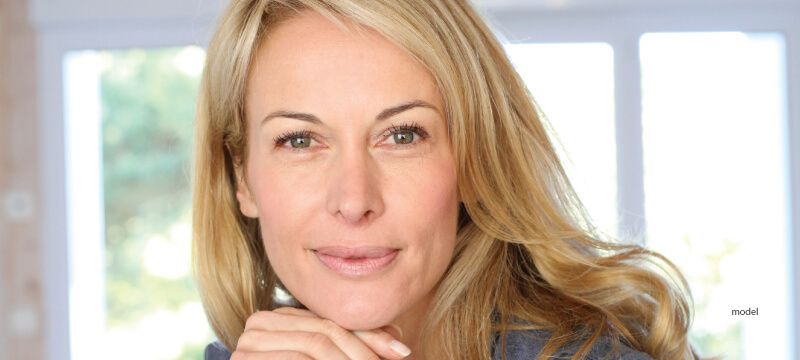Sculptra Vs. Radiesse: What’s The Difference

Sculptra and Radiesse are two popular dermal fillers, each with the ability to address common signs of facial aging including lines, wrinkles, and volume loss. Both fillers are classified as collagen biostimulators, that is they work to promote the growth of collagen and other skin firming proteins far after being injected. Additionally, Sculptra and Radiesse an often be used to address the same facial areas and both treatments are minimally painful and require no downtime.
With so much in common, its no wonder why many prospective filler patients consider Sculptra and Radiesse to be equivalent. However, nothing can be further from the truth. There are some very sizeable differences between these two injectables.
Here’s how Sculptra differs from Radiesse, along with a rundown of the formula characteristics, benefits, drawbacks, and common applications for each filler.
Formula
Sculptra uses a formula containing the material called poly-L-lactic acid which is a synthetic material that is able to be absorbed by the body over time. It’s the same material used in implantable medical devices like dissolvable stitches and sutures. Sculptra uses an inflammatory response in order to trigger collagen production and thicken the skin. After being injected into the skin, Sculptra triggers the body’s immune system to create fibroblasts which surround the foreign body (filler). The process results in the production of collagen in the area, resulting in skin firming and thickening.
Radiesse is an injectable filler that combines a gel with tiny calcium microspheres called calcium hydroxylapatite, which is structurally similar to what is found in the bones and teeth. Like Sculptra, Radiesse is a biostimulator that activates fibroblasts to stimulate collagen production. However, Radiesse is non-inflammatory. Instead the calcium particles become embedded in the skin and act as a scaffold that promotes the growth of new surrounding tissue.
Results
Both fillers have the ability to correct significant amounts of volume loss, which is the cause of sunken facial areas and sagging skin. Both Sculptra and Radiesse are also very good at addressing deep folds including the nasolabial folds. Both fillers can also address skin depressions like scars and stretch marks. While they are both suitable for hand rejuvenation, the viscosity of Radiesse makes it extremely effective in contouring the hands and mask the appearance of veins or tendons.
How Soon Results Appear
One of the biggest differences between Sculptra and Radiesse is how fast results can appear. It’s important to note that biostimulators do not create immediate results as it takes time for the body to produce collagen. Sculptra is no different as the filler requires between a few weeks and a month before the final desired end result is achieved. Radiesse is a little different since it provides an immediate volumizing effect (due to its highly viscous nature) combined with the long-term benefit of extended collagen production.
Result Duration
All dermal fillers provide temporary results. Eventually the body naturally degrades the filler resulting in the return of the treatment area to its pre-treatment state. Result duration can vary greatly as explained in this previous blog post. It’s also important to mention that several factors beyond a fillers formulation can determine how long results last, including the patient’s metabolism.
With that said, Radiesse and Sculptra are two of the longest lasting fillers on the market today. Sculptra lasts longer, with results sustaining for up to 24 months. The results of Radiesse typically last for up to 1 year. The results of both fillers can be sustained by undergoing periodic maintenance treatments.
Treatment Areas
Both Radiesse and Sculptra can address significant volume loss in the cheeks, temples, around the eyes, between the mouth and nose, and hands.
The inherent viscosity of Radiesse makes the filler not suitable for superficial placement which does somewhat limit its placement. Radiesse cannot be used in areas with thin skin.
Pain
In theory, patients may experience more discomfort during a Radiesse injection compared to a Sculptra injection since Radiesse must be injected deeper in the skin. However, both treatments are non-surgical and minimally painful, especially when performed by a skilled injector. Additionally, a topical numbing cream can also be used to minimize patient discomfort before injecting either filler.
Downtime
Both Radiesse and Sculptra require no downtime (recovery time). Patients are able to go right back to normal daily activity right after injection. Sculptra does, however, require a bit more aftercare. For the first five days following injection patients are encouraged to give the treated area a five-minute massage multiple times per day.
Disclaimer: The contents of the Westlake Dermatology website, including text, graphics, and images, are for informational purposes only and are not intended to substitute for direct medical advice from your physician or other qualified professional.

I was under the impression this page was providing information between Sculptra and Radiesse. The second half of the read is about Sculptra compared to Restylane??
Can we stick on subject please? … or at least compare all three.
I believe this page needs proper editing to stay on subject of Sculptra vs Radiesse
Hi Sahar, thanks so much for pointing this out! It looks like there was some sort of issue that occurred with publishing. Dr. Buford will review this post shortly and make the necessary corrections.
Thanks again for catching it and reaching out!
WD Staff
??? I don’t see Restylane mentioned anywhere!!
Great blog post, one of my employees showed it to me earlier and we started referring our patients to it when they ask the difference between these.
Hey!
I went to a specialist for my cellulite under my butt and on my butt. For under my butt she used Morpheus 8 and for my butt she did a treatment of RADIESSE but after she injected the treatment I didn’t notice any changes but now kind of noticing my butt looking worse.
Is this even possible or am I just paranoid I truly can’t tell. It almost seems like I’m noticing more dimples now.
Hi Ness,
I’m sorry to hear about the issues, but we greatly appreciate you sharing your experience with our readers. Dimpling can occur, typically with improper injection. However it is also possible that the dimpling will resolve once the Radiesse settles.
The other good news is the results of Radiesse is temporary, so you will not be stuck with any unwanted results permanently.
If you do still notice dimpling, you may want to return to your provider. Most providers will work to correct the issue.
We hope that helps!
WD Staff